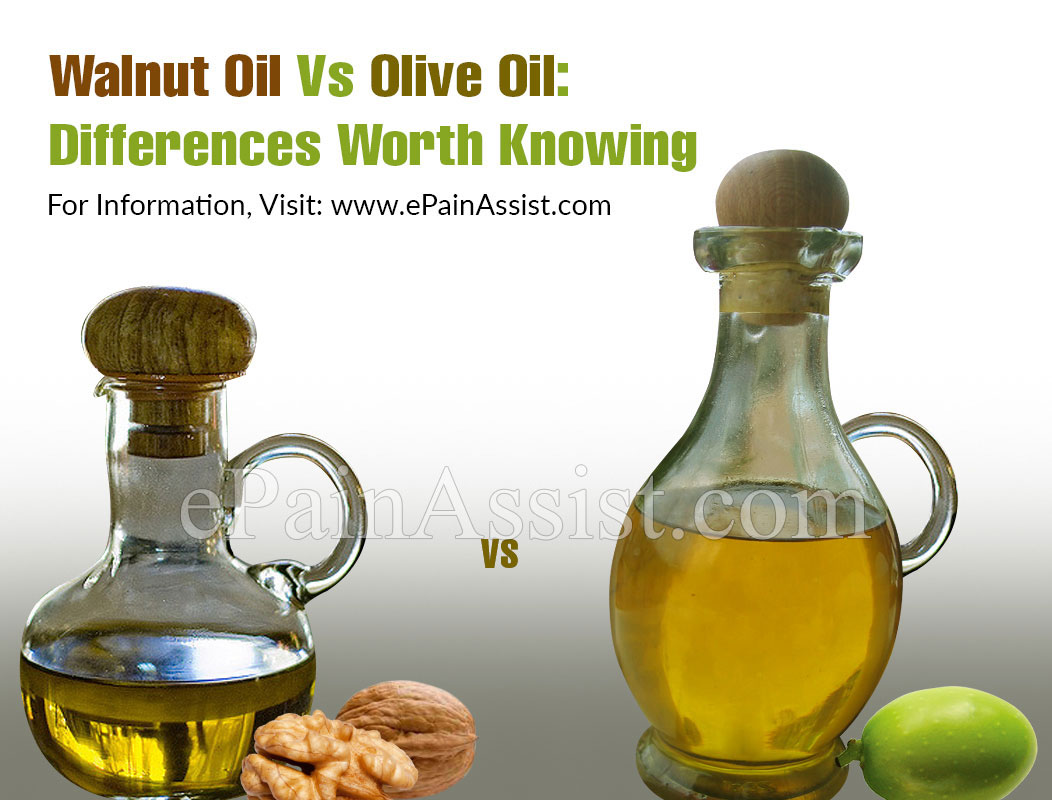Most of us know the benefits of olive oil and it is pretty commonly used by us. However, walnut oil is also a healthier choice and it can be used as a nice change from olive oil. Both of these oils are high in healthful unsaturated fatty acids and have great health benefits. Now, how exactly these two oils differ from each other? Read below to know the differences between walnut oil and olive oil.

Walnut Oil Vs Olive Oil: Differences Worth Knowing
Walnut Oil Vs Olive Oil: Differences Based On Fatty Acid Contents:
Walnut oil is loaded with Omega 3 fatty acid ALA. Some of it is converted to two other omega 3 fatty acids, namely EPA and DHA, which can reduce inflammation in the body and also protect against heart disease. Walnut oil has about 10 times more ALA than olive oil. Walnut oil is 23% monounsaturated fatty acids and 63% polyunsaturated. However, olive oil is about 73% monounsaturated fatty acids and 11% polyunsaturated fatty acids.
Walnut Oil Vs Olive Oil: Differences Based On Shelf Life:
Walnut oil has got a limited shelf life, and it is about 6-12 months. However, the shelf life of olive oil is variable, and it is based on the olive variety, the ripeness when pressed, care taken in processing and filtering. It also depends on the storage after, it has left the oil producer. So, it is difficult to guarantee a specific lifespan of olive oil. It can be as little as 3 months, for an unfiltered late harvest olive bottled in clear glass and sold off a supermarket above hot deli foods, which is then stored by the user in bright light on a hot stovetop with the cap unscrewed. It can also be as much as 304 years for an early harvest, high polyphenol containing olive variety which has been filtered then packaged in a well sealed dark or tin bottle, and then stored in a cool dark place for the grocer as well as the user after purchasing.
It must be mentioned that it is always good to buy the oils in small qualities and use them up within 6 months.
Walnut Oil Vs Olive Oil: Differences Based On Smoke Point:
It is important to know the smoke point of oils, because heating oil to the point where the oil begins to smoke, produces toxic fumes and harmful free radicals. For high temperature cooking, you must choose cooking oils with a high smoke point, however; for low temperature cooking, or for adding to dishes and salad dressings, you need to choose oils that contain a higher Omega-3 fatty acids, as they promote healthy cells and reduces the risk of stroke and heart attack.
Unrefined walnut oil has a smoke point of 160 degree C or 320 degrees F, and thus, it is easily damaged when heated to a high temperature. It is best used in small amounts, for salad dressings. This oil has a rich nutty flavor.
However, the smoke point of Olive oil varies considerably and it is based on the quality of the oils and the way in which the oil has been extracted. Pomace, virgin, extra virgin and extra light oils, all have different qualities; however, all are loaded with monounsaturated fat, and this makes them healthy for the heart. Olive oil, has a high smoke point, and the more refined the oil is, the higher is the smoke point. Extra virgin olive oil breaks down at a lower temperature, and is, therefore, best kept for uncooked uses. Extra virgin olive oil has a smoke point of 16o degrees C or 320 degrees F, Virgin Olive oil has 216 degrees C or 420 degrees F, Pomace oil has 238 degree C or 460 degrees F, and Extra light Olive oil has 242 degree C or 468 degree F.
Walnut Oil Vs Olive Oil: Differences Based On Color and Taste:
Coming to the color and taste of walnut oil, a good quality walnut oil is topaz in color and has a rich nutty taste. While, olive oil may vary in their color, from dark green to golden yellow and also brown. The taste of a golden yellow olive oil, is almost sweet.
Walnut Oil Vs Olive Oil: Differences Based On Their Health Benefits:
Walnut oil is good for the heart health and it is also helpful in preventing excessive bleeding and help blood clot.
Extra virgin olive oil is beneficial in protecting your memory and can prevent dementia, reduce inflammation in the body and also help in treating skin conditions like psoriasis, eczema, along with conditions like arthritis.
Conclusion:
So, the bottom line is that it is good to use extra virgin olive oil in salads or to add to cooked foods, but not for high temperature cooking. Unrefined walnut oil is also good; however, again, only for low temperature uses. It must also be mentioned that whenever possible, purchase and use organic, unrefined, cold-processed vegetable oils.
- “The Health Benefits of Olive Oil and Walnut Oil” – Healthline (Link: https://www.healthline.com/nutrition/olive-oil-vs-walnut-oil)
- “Walnut Oil: Healthy or Unhealthy?” – WebMD (Link: https://www.webmd.com/diet/walnut-oil-healthy-unhealthy)
- “Olive Oil: Nutrition, Benefits, and Uses” – Verywell Fit (Link: https://www.verywellfit.com/olive-oil-nutrition-facts-calories-and-health-benefits-4119928)
Also Read:
